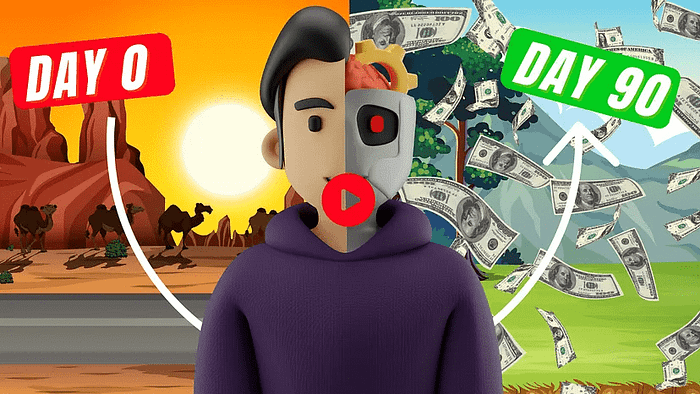How I Do More By Doing Less With The 80/20 Rule: A Million-Dollar Print-on-Demand Journey
Discovering the magic of doing less transformed my entire business approach, leading to over a million dollars in revenue through print-on-demand. The revelation came when I least expected it, during a moment of overwhelming burnout from managing thousands of product listings across multiple platforms. This powerful principle, known as the Pareto Principle or the 80/20 rule, became the cornerstone of my success, showing me that excellence doesn’t always require more effort – sometimes it requires smarter choices and strategic thinking that fundamentally changes how we approach business growth and sustainability.
We strongly recommend that you check out our guide on how to take advantage of AI in today’s passive income economy.
Table of Contents
Understanding the 80/20 Rule in Print-on-Demand
The fundamental concept behind the 80/20 rule is beautifully simple yet profoundly impactful: 20% of your efforts generate 80% of your results. In the print-on-demand world, this principle manifests itself in ways that initially seemed counterintuitive to me. When I launched my business, I believed that more designs meant more success. However, by doing less and focusing on quality over quantity, I discovered a path to greater prosperity that required less time and energy. This realization didn’t come easily – it emerged from countless hours of analyzing data, tracking performance, and recognizing patterns across thousands of listings. The beauty of doing less lies not in being lazy or cutting corners, but in being incredibly strategic about where you invest your time and creative energy.
What makes the 80/20 rule particularly fascinating in print-on-demand is how it cascades through every aspect of the business. From design creation to niche selection, marketing efforts to customer engagement, this principle consistently proves that focused effort on the right elements yields disproportionate returns. The challenge lies not in working harder, but in identifying exactly which aspects of your business deserve that focused attention.
The Reality of Print-on-Demand Success Metrics
My journey through print-on-demand revealed a fascinating pattern that goes even deeper than the basic 80/20 rule. After analyzing data from thousands of listings, I found that success often follows an even more concentrated ratio. In fact, roughly 4% of total listings – the cream of the crop within that successful 20% – typically generate the majority of revenue. This insight revolutionized my approach to doing less while achieving more, leading me to completely restructure how I allocated my time and resources.
This concentrated success pattern isn’t just about having a few lucky bestsellers. It’s about understanding the DNA of your successful products and leveraging that knowledge to create targeted expansion strategies. By doing less random experimentation and focusing more on proven patterns, I was able to replicate success more consistently while actually reducing my overall workload.
Finding Your Winning Formula
The key to leveraging the 80/20 rule effectively lies in identifying your highest-performing elements. Through meticulous tracking and analysis, I discovered that by doing less random testing and focusing more on proven winners, my success rate increased dramatically. This approach meant spending more time refining and expanding successful design concepts rather than constantly creating new ones from scratch. The process involves deep market research, customer feedback analysis, and careful observation of buying patterns – all focused on understanding what makes certain designs resonate while others fall flat.
Creating a winning formula isn’t about finding a single successful design and copying it endlessly. Instead, it’s about understanding the underlying principles that make certain designs successful and applying those principles strategically across different niches and product categories. This approach to doing less actually requires more thoughtful consideration and strategic planning, but the results far outweigh the initial investment of time and energy.
The Power of Niche Selection
One of the most valuable lessons I learned about doing less was in niche selection. Rather than spreading myself thin across dozens of categories, I focused intensively on the niches that showed the most promise. This concentrated effort allowed me to develop deeper market understanding and create more resonant designs, all while doing less overall work. The key was identifying niches with passionate, engaged audiences who were willing to pay premium prices for designs that truly spoke to their interests and identity.
Niche selection isn’t just about finding popular categories – it’s about finding the sweet spot where your design capabilities intersect with market demand and reduced competition. By doing less scattered niche exploration and focusing more on developing authority within specific niches, I was able to build stronger brand recognition and customer loyalty. This focused approach also made it easier to predict trends and anticipate customer needs within my chosen niches.
Scaling Smart, Not Hard
The beauty of doing less with the 80/20 rule lies in its scalability. Once you identify a winning design style or niche, the path to growth becomes clearer. Instead of creating hundreds of unrelated designs, I learned to take successful concepts and adapt them thoughtfully across related sub-niches, maximizing return on effort while doing less overall work. This approach required developing a systematic method for identifying design elements that resonated with customers and understanding how to adapt these elements across different contexts without losing their essential appeal.
My scaling strategy evolved from frantically creating new designs to methodically expanding proven concepts. For instance, when a particular design style performed well in one professional niche, I would carefully adapt it for related professions, maintaining the core elements that made it successful while customizing the specifics for each audience. This approach to doing less but better resulted in higher success rates for new listings and more efficient use of creative resources.
The Financial Impact of Focused Effort
By applying the principle of doing less to my business strategy, I transformed my monthly revenue significantly. What started as a scattered approach yielding inconsistent results evolved into a refined system generating between $1,500 to $3,000 monthly from just a small percentage of my total listings. This success came not from doing more, but from doing less with greater focus. The financial transformation wasn’t immediate – it required patience and consistent application of the 80/20 principle across all aspects of the business.
The most remarkable aspect of this financial growth was its sustainability. By focusing on high-performing designs and niches, I created a more predictable revenue stream while actually reducing the time and effort required to maintain it. This approach to doing less allowed me to reinvest my energy into strategic planning and market analysis rather than constant content creation.
Implementing the Strategy
Success in print-on-demand through doing less requires a systematic approach. I developed a detailed tracking system that monitored not just sales numbers, but also customer engagement metrics, seasonal trends, and design element performance. This data-driven approach to doing less meant I could make informed decisions about where to focus my energy, rather than shooting in the dark. The system helped identify patterns in successful designs that might not have been immediately apparent, allowing for more strategic expansion efforts.
The implementation process involved creating clear criteria for evaluating design performance and establishing thresholds for when to scale a design concept versus when to move on. This structured approach to doing less eliminated much of the guesswork from the business while improving overall outcomes. It also helped maintain focus during market fluctuations and seasonal changes, ensuring that business decisions were based on data rather than emotion.
The Testing Phase
While the goal is doing less overall, initial testing remains crucial. I learned to conduct focused testing periods, carefully tracking performance metrics to identify potential winners quickly. This approach to doing less meant being more strategic about new designs rather than eliminating testing altogether. The testing phase became more about quality than quantity, with each new design being thoroughly evaluated against established success criteria.
Testing evolved from a scattered, high-volume approach to a more targeted strategy. Instead of launching hundreds of random designs, I would create small, focused collections based on proven success patterns. This approach to doing less but better allowed for more accurate assessment of market response and faster identification of potential winners.
Maximizing Return on Effort
The true power of doing less comes from maximizing the return on every hour invested. By concentrating on proven winners and systematically expanding within successful niches, I found that doing less actually led to greater profitability. This approach eliminated the exhaustion of constant creation while improving overall results. It also allowed for better resource allocation, ensuring that time and energy were invested in activities with the highest potential return.
A key aspect of maximizing returns while doing less involved developing systems for quick replication and adaptation of successful designs. This included creating design templates, maintaining organized asset libraries, and establishing clear processes for scaling successful concepts. These systems made it possible to maintain quality and consistency while reducing the time and effort required for new product creation.
Sustainable Growth Through Focus
One of the most valuable benefits of doing less is the sustainability it brings to your business. Rather than burning out from constant content creation, focusing on proven winners allows for steady, manageable growth. This approach to doing less creates a more sustainable and enjoyable business model. It also provides the mental space needed for strategic thinking and innovation, rather than being caught in the endless cycle of content creation.
The sustainable growth model developed through doing less has proven particularly valuable during market fluctuations and seasonal changes. By maintaining a focused approach and strong understanding of core successful elements, the business became more resilient to external changes while requiring less constant adjustment and intervention.
Long-term Strategy and Success
The 80/20 rule isn’t just about doing less – it’s about building a sustainable business model that can grow over time. By focusing your efforts on what works best, you create a foundation for long-term success without the burnout that often comes from trying to do everything at once. This approach requires regular review and adjustment of strategies, but the focused nature of the work makes it manageable and sustainable.
Looking ahead, the principle of doing less continues to guide my business decisions. By maintaining focus on high-performing elements and systematically expanding within proven niches, I’ve created a scalable model that grows without requiring exponentially more effort. This strategic approach to growth ensures that expansion happens thoughtfully and sustainably, rather than through unsustainable bursts of activity.
Conclusion: The Power of Strategic Minimalism
The journey of doing less while achieving more through the 80/20 rule has transformed not just my business results but my entire approach to entrepreneurship. By focusing intensively on what works and eliminating unnecessary effort, I’ve built a more profitable and sustainable business model. The key lies not in working harder, but in working smarter through strategic focus and intentional action.
Remember, success in print-on-demand isn’t about creating endless designs or testing every possible niche. It’s about identifying your most profitable opportunities and maximizing their potential through focused, strategic effort. By embracing the power of doing less, you can achieve more than you ever thought possible, while maintaining the energy and enthusiasm needed for long-term success in this dynamic industry.
The most important lesson learned through this journey is that doing less doesn’t mean achieving less – it means achieving more through strategic focus and intelligent resource allocation. This principle, when properly applied, can transform any print-on-demand business from a time-consuming struggle into a sustainable, profitable enterprise.

We strongly recommend that you check out our guide on how to take advantage of AI in today’s passive income economy.




